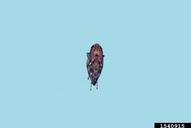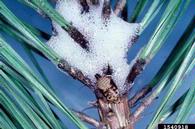Pine spittlebug
Aphrophora parallela (Say) (Hemiptera: Cercopidae)
Orientation to pest
Pine spittlebug, Aphrophora parallela (Say), is a native insect in North America that is found in most of the eastern United States and adjacent southern Canada. Adults and nymphs develop on the same plant species. The most favored host is Scots pine (Pinus sylvestris L.). Eggs are deposited under bark and are the overwintering stage. Nymphs initially feed on twigs, but later move to the trunk, forming protective spittle masses each time they move. Adults return to twigs to feed. There is a single generation per year. Feeding of this spittlebug promotes the spread of a pathogenic fungus, Sphaeropsis sapinea (synonyms S. ellisii and Diplodia pinea), which invades weakened trees through spittlebug feeding punctures. This fungus is responsible for a considerable part of the dead branches associated with this insect.
Hosts commonly attacked
Pine spittlebugs seem to prefer Scots pine but are also found on six other pines, three species of spruce (Picea), balsam fir (Abies balsamea [L.] Miller), larch (Larix), and eastern hemlock (Tsuga canadensis (L.) Carrière).
Distribution
Pine spittlebug is found throughout the eastern United States and adjacent parts of southern Canada.
Images of the pine spittlebug
| Figure 1. Adult of pine spittlebug, Aphrophora parallela | Figure 2. Spittle mass pushed aside to show nymph of pine spittlebug |
Important biological control agents related to this pest species
The fungus Entomophora aphrophorae Rostrup at times causes high mortality to nymphs.
Web links for information on the pine spittlebug
- BugwoodWiki article | wiki.bugwood.org
- IPM of Midwest Landscapes Fact Sheet | University of Minnesota
- Sphaeropsis blight or Diplodia tipblight of pines | University of Illinois Extension
Report on plant disease - Fact Sheet from Maine Forest Service | State of Maine Department of Conservation
Articles
- Wilson, L. F. and D. G. Mosher. 1981. How to identify and control pine spittlebug [Aphrophora parallela]. North Central Forest Experiment Station, USDA Forest Service, St. Paul, Minnesota. 6 pp.





